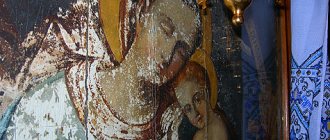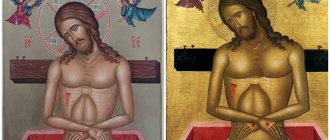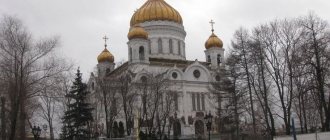The halo around the head of the saint is a very important detail in Orthodox iconography. Its significance is evidenced by the fact that traditionally, when painting an icon, they determine the space that the halo occupies. The further construction of the composition depends on this.
The halo of the main figure should be at the apex of an equilateral triangle (symbol of the Holy Trinity), the sides of which coincide in size with the sides of the base (the symmetry of the icon is a symbol of the correctness and perfection of the depicted heavenly world).
Halo on the icon of the Virgin Mary
God
- Θεος
- God (Greek) - Bg
- God - Where
is the Lord
Jesus Christ
- IC XC, ΙΣ ΧΣ
- abbreviated spelling of the Greek name. Ιησους Χριστος[3] - IIS XC
is an abbreviated spelling of the name of Jesus Christ. Distributed after the church schism of the 17th century. as a response to the traditional Russian spelling of the name “Isus” with one “i”, supported by the Old Believers, one of whose arguments was the inscription “IC XC” on ancient icons[3]. - IСЪ ХСЪ
- Isus
- ΙΧΘΥΣ
- literally “fish”, Greek acronym for Greek. Ιησους Χριστος Θεου Υιος, Σωτηρ - Jesus Christ the Son of God, the Savior [3] (see ichthys). - ο ων
(Greek) - an abbreviated spelling of the name of God “I am”, “I am who is” - “I am who is” (Exodus 3:14). The inscription of the name of the Holy Trinity on the cross-shaped halo on the icons of Jesus Christ [3]. - King of Glory
- King of Glory
History of the halo
The image of a halo, as an attribute of a celestial being, is known in various religions, both in Buddhism and among many pagans, and appeared long before Christianity.
The word “nimbus” itself comes from the Latin “nimbus”, meaning “cloud”. The Greeks and Romans believed that the Olympian gods, when they descend to earth, appear before people in a radiant radiance, in a cloud of light. This was reflected in their images. Also in Ancient Rome, halos could be on portraits of emperors. After all, the ruler was also considered a god, and power was sacred.
Christians adopted the external forms of this tradition, but filled them with their own, completely new meaning.
Crucifixion of Christ
- I.N.
Ts.I. - an abbreviated inscription on the images of the “Crucifixions”, a sign of the words written in three languages (Hebrew, Greek and Latin) by Pontius Pilate on a tablet nailed above the head of the Savior: “Jesus of Nazareth, King of the Jews” (see INRI)[3] - ML RB
- abbreviation for “the place of the frontal paradise was”, or “the place of the forehead was crucified” inscription when depicting the Crucifixion[3] - ΤΚΠΓ (Greek) - short for Τουτο (or Τουτο) Κρανιον Παραδεισος Γεγονε - analogue of the Russian inscription MLRB [3]
- GG
- Mount Golgotha, the inscription at the foot of the Cross when depicting the Crucifixion[3]. - GA
- Adam's head (symbol), inscription on the skull depicted at the foot of the Crucifixion[3] - K
- copy - one of the instruments of passion, depicted at the Crucifixion (see Spear of Destiny) [3] - T
is short for “cane” - one of the instruments of the passions, depicted at the Crucifixion[3] - CT is an abbreviation for “spear” and “cane”, the signature of the instruments of the passions in images of the Crucifixion[3].
Halos other than a circle shape
In Byzantine icon painting, you can find images of square halos. They had their own semantic content. If the circle is eternity, then the square is the otherworldly, the world of the earth.
The saint with a quadrangular halo is depicted in his earthly life. And the color of such a halo is not gold, but white. That is, this is not yet given in full Divine grace, as in the heavenly world, but transforming, gradually revealing itself on earth.
Other traditions can be found among Catholics. On Catholic icons, the radiance often forms a kind of crown over the head of the saint. Light descends on him from above, from outside. Then, as in the Orthodox image, the grace of God sanctifies a person from the inside, permeates everything created.
Revered Orthodox icons:
An Orthodox icon is a shrine. It is needed so that the Prototype is revealed to the believer through the image.
It is called “prayer in colors”, “a window to the Heavenly World”. Such tasks of icon painting as an art form required the creation of a special artistic language. It can be called symbolic realism. There is no naturalism here, because we are talking about a world that has already been completely transformed, but there are no abstract symbols or allegories.
After all, it is people, real earthly people, who must be transformed. Here matter is combined with Spirit, the visible with the invisible, the human with the Divine.
And the entire icon as a whole, and each of its parts: halos, clothes, objects, colors, lines, composition, through the symbol lead to the Source of being.
The date of the Second Coming is indicated on the halo of Christ
The icons of Christ always indicated the time - the date and place of His Second Coming, as well as His new Name. The information was contained in the letters located in the halo of the Savior’s head, as well as in the abbreviated form of His name - ICXC
What is the object of research, and what should be taken into account when assessing the discovered hidden meaning?
The object of the study is an inscription unique to the image of the face of Jesus Christ. These are the letters - WON, located on the halo around the head of Christ, and the letters of the initials of Christ, located behind the halo on both sides of the head - IC and XC.
The inscription is found in two versions - in Greek and Church Slavonic.
In Greek writing, the order of the letters is as follows: O (omicron) W (omega) N (nu). In Church Slavonic it’s different: W (from) O (he) N (our). In modern reading in Russian, the inscription reads as UN. One way or another, it is believed that these three letters mean the word Jehovah, one of the names of God. The letters IC and XC, meaning the initials of Jesus Christ, are generally unchanged and represent an abbreviation of the first and last letters of his name.
It turned out that the letters, in their first historical entry on the halo of Christ, in accordance with the rules of writing in the Church Slavonic language, meant numbers. This is evidenced by the “titlo” sign found on old icons, which was used to write numbers in letters, to abbreviate words, and since the 15th century - as a sacred system for writing words. Over time, as a result of the loss of primary meaning, the title above the letters on Christ’s halo was no longer renewed and depicted, and the letters WON began to be read as UN, equating them with the word Jehovah, with reference to the iconographic tradition. The realities are such that modern exegesis (interpretation of the Holy Scriptures) DOES NOT KNOW EXACTLY when the letters on the halo of Christ were introduced into the church tradition, and, therefore, their initial meaning.
Based on the instructions of the Holy Scripture, God has no accidents, everything happens according to His Will, from which it follows that what directly connects God with man, or what is associated with Him, is under strict control - His Word and the iconographic Face. From here comes the opposite - that which does not lead to God is not sanctioned by Him as useful for Him and man, and would not have been allowed by Him in a natural way even before man with his mind imposed a ban on something. Thus, everything that exists in the world, actions or information, has a place to be, but what color it will take on - positive or negative - depends on the various qualities of a person.
When analyzing the Biblical text, from the perspective of the full application of the ancient Greek and Church Slavonic alphabets, i.e. using their alphanumeric correspondence, it turned out that the original meaning of the inscription on Christ’s halo reflected part of the sacred information of the text of the Holy Scriptures.
As can be seen from the picture, the numerical values of the letters on Christ’s halo hid the date of His Second Coming, and the familiar name Jesus Christ contained an indication of the place of His Coming into the World - Russia.
Let's look at the Arrival Date first.
The sacred layer of the Sacred text does not just dryly indicate the date and place of the Coming of God to Earth - the main expected event for all believers. Scripture explains how this will happen and what stages of history will precede and accompany the immediate Coming of God. One of these stages is the discovery of the Word of God in the language of the people whose territory God has chosen for his next Visit. This event is a test for His “chosen” people - whether God should visit the place where His Word of God ahead is rejected by this people.
Therefore, when the revelation of the sacred, planned from above, took place - the true meaning of the Holy Scriptures about where and when the Coming of God into the world of people took place, in confirmation of this, events marking His Coming began to occur all over the world. The analysis of these events, in turn and in due time, led to the discovery of the same hidden information on the main shrine for all believers - the icon depicting the face of the Savior.
The figure taken as an example shows a modern list of the icon of Jesus Christ and two alphabets with alphanumeric correspondence - Church Slavonic (valid to this day) and modern Russian. The alphabets were chosen depending on the execution of the inscription on the halo and on the Russian language in which the Sacred Texts revealed their Secret.
As can be seen from the transcript, the letters depicted on the halo hid a specific date - August 11, 1999. This date, as a hidden indication of the Coming of God, can be found in the text of the Bible Scripture:
Matthew 1:18. The birth of Jesus Christ was like this... Zechariah 8:11. And now.. I am not the same as in the old days..
Since the Nativity of God, His Resurrection and His Coming, in the symbolic language of Scripture, means the same thing, then the date - 8/11/1999, applies equally to all these events.
More information about the date of the Nativity of Christ can be found on the website in the article “The Coming of the New Year or the Christmas of NEW GOD?”
The Secret Code of the Holy Scriptures is structured in such a way that the information contained in Them is duplicated several times in the text of the Scripture itself, then in the texts of other “other faith” Scriptures, and then, progressively, in various sources of the peoples of the world, as related to spiritual verbal monuments of history, and to secular areas of other knowledge, far from religion. This is a real information matrix, repeating the structure of the universe. Therefore, when the Code of the Sacred Texts is discovered, and with the help of it all surrounding information and ongoing events begin to be read, then with each new example the doubt about the discovery of the Code decreases, because a systemic pattern is revealed, and vice versa - mistakes made in various areas of society become obvious, be it religion or politics.
How can you see the date of His Coming in the letters on Christ’s halo?
Since information about the Coming of God into the world of people was considered prophetic in its historical time, it was therefore designed to be read at the moment of the fulfillment of the prophecy, i.e. during the very Coming of God into the world, but ahead of the time of His immediate Appearance.
One of the indications of the language of the people with the help of which information about the Coming of God will be read, as indicated in the example of decoding, is the name itself - Jesus Christ, which turned out to be an anagram of the words RUSSIAN, or IS RUSSIA.
Further, already relying on the Russian alphabet, on its alphanumeric correspondence, and having for analysis examples of the connection of the Nativity of Christ with the number-date 118 from the Biblical text (Matt. 1:18, Zech. 8:11.) and other sources , a reading of the exact time of the Second Coming was revealed.
As can be seen from the example decoding, the Greek tradition of writing the letters on Christ’s halo - OWN, or their numerical value - 785, and the reverse reading - 587, only indicated a sign of the times that determines the Coming of God. On the contrary, the writing of the sequence of letters in the Russian tradition - WON, their bchz - 875, and the reverse reading - 578, gave an indication of the first persons of the state under whom the Coming was to take place, and through them on the exact date - 11.8.1999, as in writing in numbers and writing numbers in words. An additional combination of numbers, obtained from the correspondence of three letters WON (or OWN) - 875, gave an indication of the secular name of the first clergyman of Russia - the Patriarch of All Rus', also thereby determining and confirming the exact date of the Coming.
785 - Global crisis of the world economy - the time of the Coming of God to Earth 587 - this is a sign of the Coming of God to planet Earth 875 - The Coming of the Lord to Earth will take place during the time of Vladimir Putin Dmitry Medvedev 578 - 1181999 - the Coming of God to planet Earth will take place 758 - the eleventh of August one thousand nine hundred and ninety-nine (08/11/1999) 875 - The Coming of the Lord to Earth will take place during Ridiger Alexei Mikhailovich
It should be noted the order in which correspondence to the letters WON is discovered will signify the time of the Coming of God. To do this, we took the following sequence of alphanumeric correspondence, as if the numbers were located on the halo instead of letters, and (!) without zeros, i.e. direct replacement – 875= WON – in the Russian writing tradition, according to the numbering of the Church Slavonic alphabet; and the phrases “signs of the times” have already been counted according to the modern Russian alphabet, according to its continuous numbering - from A-1 to Z-33. This approach to deciphering is due to the indication (even within the content of the icon itself) precisely on the features of the Russian alphabet, on what it is on the date of the Advent - on August 11, 1999.
As mentioned above, the Code of the Holy Scriptures is designed in such a way that the information read with its help is necessarily duplicated several times, starting directly from the place where it was found. Using the example of the inscription on the halo of Christ, this duplication was hidden in the word-name of God - Jehovah. Through the alphanumeric correspondence of the Russian alphabet, it is equal - 88 - to the word Rus, which is consistent with the secret information hidden in the name of Christ that He is Russian.
88 – Existing 88 – Rus'
Also, near the place where the date of the Advent was indicated, which was read in the letters of the halo located around the head of Christ, a record duplicating this date was discovered. The reading code was in the same sequence: first, correspondence with Church Slavonic numbering, then reading through the bchz of the Russian alphabet.
The duplication of the Advent date was hidden in the letters A (alpha) and W (omega), which were placed on icons of Christ even before the halo was introduced into the tradition, and which are sometimes found in modern versions, in addition to the letters WON.
In the Greek alphabet, the letters A (alpha) and W (omega) have corresponding numerical values of 1 (one) and 800 (eight hundred). If we write the numbers in words as “one + eight hundred,” then their total alphanumeric value—189—will be the same as the phrase “date of the Advent.” And if you count the number of words “alpha and omega”, then it will show this calendar date of the Advent, equal to 118, which is an abbreviated symbolic notation of 11.8.1999.
189 – one + eight hundred. 189 – date of the Coming. 118 – Alpha and Omega.
There are several places in the biblical text that explain what is hidden in the letters on Christ's halo, but this requires an explanation of another method of decoding, which is not the purpose of this article.
In conclusion, I would like to draw special attention to the equality of the words Advent and Apocalypse. Their direct relationship should be understood as follows: either people will understand and accept information about the Advent, with the corresponding consequences, or suffering on the independently chosen path of the Apocalypse will continue. Refusal to meet God on the date He appointed automatically turned on the destructive effect of the Apocalypse. There is only one way to stop Earthly troubles - agree to meet with God while He is on Earth. Refusal to meet will doom the planet's population to guaranteed death. Demands to accept God, as befits His status, come to Earth every day, through the indication of the date of the Coming - August 11, 1999, through the number of His Name - 118.
In fact, this information can be considered the last in a series of people’s preparation for God’s Coming. Everything else is just in words and eye to eye. And if there is no faith in what is shown from God, then there is no promise from Him. The authorship of this should be clear to everyone, for it can only be the only true one. We Are Who We Are. 01/05/2010
There are things that in certain circles are considered “generally known”; it is all the more surprising to come across an opinion that contradicts what, it would seem, all Orthodox Christians should know.
And I had to be convinced of this more than once. Thus, for those who know the “Law of God” as part of Sunday school, this material can be skipped... And for those interested, I present a new article for the March issue of the magazine “Vine”.
Images of saints in Orthodox iconography have one common attribute - a halo. A halo, as we know, is a circle symbolizing the holiness of the person depicted (sometimes, a halo can also signify the royalty of a character or, in more rare cases, accompany a figure that is an allegory of a time of day, a natural phenomenon, a city or a country).
All halos are, to a greater or lesser extent, the same type, and only the halo of the Lord Jesus Christ has certain differences.
Even during the period when the iconography of the Savior was just taking shape, various attempts were made to highlight His image with various signs. For example, the monogram of Christ was inscribed in the halo (the combined Greek letters “chi” and “rho”, the so-called “chrisma”), and on the sides of the figure of the Lord the first and last letters of the Greek alphabet “alpha” and “omega” were written (“I am Alpha and Omega, the beginning and the end, says the Lord, who is and who was and who is to come, the Almighty." (Rev. 1:8)). Which once again demonstrates the Divinity of Christ.
Later, the main symbol of our salvation, the cross, began to be depicted in the Savior’s halo. This attribute is very firmly entrenched in the iconography of Christ and remains to this day an almost indispensable attribute of it. Such a halo is called a cross halo.
The shape of such a cross was different at different times, as was the color. The cross could be white, golden ocher, red, purple, or sky blue.
It could be flat, have a conventional volume, simple or decorated with “jewels”.
Over time, the Greek word “ό ών”, which means “He who is,” began to be inscribed in the three visible blades of the cross. “ And Moses said to God: Behold, I will come to the children of Israel and say to them: The God of your fathers has sent me to you. And they will say to me: What is His name? What should I tell them? God said to Moses: I am who
.
And he said, “Thus you shall say to the children of Israel: Jehovah has sent me to you.” ( Exodus 3:13,14)
For a long time, Constantinople was the center of development of Christian iconography; it is all the more interesting that the letters in the halo of Christ in Byzantium itself appeared relatively late, while they were already used on the periphery of the Byzantine world - for example, in Southern Italy and Rus'.
So, “ό ών”, the Greek letters “omicron” (in this case, this is a masculine article) and “omega” with “nu” (“ni” in Byzantine pronunciation), in fact, the word “being” itself. Usually on icons they are located as follows: in the upper blade “omicron” and below from left to right relative to the viewer, “omega” and “nu”.
Less commonly, letters are arranged clockwise and even counterclockwise.
There are many examples in world culture when the meaning of a certain symbol is forgotten and, over time, begins to have a different meaning. Unfortunately, this happened with the letters of the cross halo. By the 16th century, practically no one knew the Greek language in Rus'. The interpretation of “ό ών” - “existing” was lost. However, I really wanted to unravel the mystery of the “mysterious letters”. Greek letters are very similar to Slavic ones (especially since the fonts at that time were practically the same), the Greek “omega”, with superscripts, was mistaken for the Slavic letter “from” T. And this already gave a certain scope for interpretation.
In Old Believer literature, which ignored Greek sources, there are several options for interpreting the new letter combination: T OH. For example: T - “hedgehog has fathers”, O - “mind”, N - incomprehensible.” Or: T - “came from heaven”, O - “they didn’t know Me”, N - “crucified on the cross” and etc. There were also popular interpretations, like: “He is Our Father.”
In the same way, the nine lines of the cross in the halo (a rudiment of volume) also began to be endowed with symbolic meaning, for example, the 9 ranks of angels. What relation the angelic ranks have to the cross of Christ is absolutely unclear, but at first glance it may seem that there is nothing terrible in these alternative readings. But still. The very tendency to attach deep meaning to random little things (like the same lines of the cross) and invent your own interpretations, ignoring the historical meaning of the symbols, can sooner or later lead to sad results. So, recently, information has been spreading that supposedly the date of the end of the world is encrypted in the Savior’s halo: https://samlib.ru/n/nostr_a_g/kod2.shtml
This technique, taking advantage of our illiteracy and inertia, is often used by various sectarian groups.
Knowledge of your tradition is the best antidote. There are things that in certain circles are considered “generally known”; it is all the more surprising to come across an opinion that contradicts what, it would seem, all Orthodox Christians should know. And I had to be convinced of this more than once. Thus, for those who know the “Law of God” as part of Sunday school, this material can be skipped... And for those interested, I present a new article for the March issue of the magazine “Vine”.
Images of saints in Orthodox iconography have one common attribute - a halo. A halo, as we know, is a circle symbolizing the holiness of the person depicted (sometimes, a halo can also signify the royalty of a character or, in more rare cases, accompany a figure that is an allegory of a time of day, a natural phenomenon, a city or a country).
All halos are, to a greater or lesser extent, the same type, and only the halo of the Lord Jesus Christ has certain differences.
Even during the period when the iconography of the Savior was just taking shape, various attempts were made to highlight His image with various signs. For example, the monogram of Christ was inscribed in the halo (the combined Greek letters “chi” and “rho”, the so-called “chrisma”), and on the sides of the figure of the Lord the first and last letters of the Greek alphabet “alpha” and “omega” were written (“I am Alpha and Omega, the beginning and the end, says the Lord, who is and who was and who is to come, the Almighty." (Rev. 1:8)). Which once again demonstrates the Divinity of Christ.
Later, the main symbol of our salvation, the cross, began to be depicted in the Savior’s halo. This attribute is very firmly entrenched in the iconography of Christ and remains to this day an almost indispensable attribute of it. Such a halo is called a cross halo.
The shape of such a cross was different at different times, as was the color. The cross could be white, golden ocher, red, purple, or sky blue.
It could be flat, have a conventional volume, simple or decorated with “jewels”.
Over time, the Greek word “ό ών”, which means “He who is,” began to be inscribed in the three visible blades of the cross. “ And Moses said to God: Behold, I will come to the children of Israel and say to them: The God of your fathers has sent me to you. And they will say to me: What is His name? What should I tell them? God said to Moses: I am who
.
And he said, “Thus you shall say to the children of Israel: Jehovah has sent me to you.” ( Exodus 3:13,14)
For a long time, Constantinople was the center of development of Christian iconography; it is all the more interesting that the letters in the halo of Christ in Byzantium itself appeared relatively late, while they were already used on the periphery of the Byzantine world - for example, in Southern Italy and Rus'.
So, “ό ών”, the Greek letters “omicron” (in this case, this is a masculine article) and “omega” with “nu” (“ni” in Byzantine pronunciation), in fact, the word “being” itself. Usually on icons they are located as follows: in the upper blade “omicron” and below from left to right relative to the viewer, “omega” and “nu”.
Less commonly, letters are arranged clockwise and even counterclockwise.
There are many examples in world culture when the meaning of a certain symbol is forgotten and, over time, begins to have a different meaning. Unfortunately, this happened with the letters of the cross halo. By the 16th century, practically no one knew the Greek language in Rus'. The interpretation of “ό ών” - “existing” was lost. However, I really wanted to unravel the mystery of the “mysterious letters”. Greek letters are very similar to Slavic ones (especially since the fonts at that time were practically the same), the Greek “omega”, with superscripts, was mistaken for the Slavic letter “from” T. And this already gave a certain scope for interpretation.
In Old Believer literature, which ignored Greek sources, there are several options for interpreting the new letter combination: T OH. For example: T - “hedgehog has fathers”, O - “mind”, N - incomprehensible.” Or: T - “came from heaven”, O - “they didn’t know Me”, N - “crucified on the cross” and etc. There were also popular interpretations, like: “He is Our Father.”
In the same way, the nine lines of the cross in the halo (a rudiment of volume) also began to be endowed with symbolic meaning, for example, the 9 ranks of angels. What relation the angelic ranks have to the cross of Christ is absolutely unclear, but at first glance it may seem that there is nothing terrible in these alternative readings. But still. The very tendency to attach deep meaning to random little things (like the same lines of the cross) and invent your own interpretations, ignoring the historical meaning of the symbols, can sooner or later lead to sad results. So, recently, information has been spreading that supposedly the date of the end of the world is encrypted in the Savior’s halo: https://samlib.ru/n/nostr_a_g/kod2.shtml
This technique, taking advantage of our illiteracy and inertia, is often used by various sectarian groups. Knowledge of your tradition is the best antidote.
Source bizantinum
Nimbus Halo or halo. Originally it personified the power of the Sun and the solar disk and, therefore, is an attribute of the Sun gods. Also symbolizes divine radiance; power consisting of fire and energy of the deity; the radiance emanating from holiness; spiritual energy and the power of light; Circle of Glory of Genius; valor; radiation of vital force coming from the head; the life force of wisdom; transcendental light of knowledge. The halo sometimes surrounds the entire figure. A round halo, or halo, signifies a dead person; a square or hexagonal halo indicates a living saint. In addition, it can symbolize the wholeness of the head of the deity, where three sides signify the Trinity, and the fourth - the head as a whole. The three rays mean the Holy Trinity. The double halo, halo or rays represent the dual aspect of the deity. The halo in the form of a cross is a feature of Christianity. A hexagonal halo indicates great virtues. The halo sometimes signifies spiritual power, as opposed to temporal power represented by the crown. Sometimes the halo is used as an attribute of the Phoenix bird as a symbol of solar power and immortality. The halo can be blue, yellow or rainbow. In Buddhism, the Red Halo of Buddha is an indicator of dynamic solar activity. In Christianity, the halo was not depicted until the 4th century. It means holiness; saint A triangular or diamond-shaped halo signifies God the Father. The halo in the form of a cross points to Christ. In Byzantine art, Satan was sometimes depicted with a halo, signifying an emission of power. In Greek mythology, a blue halo is an attribute of Zeus as the god of Heaven. Phoebus, the sun god, also has a halo. In Hinduism, Shiva's halo with a rim of flame symbolizes the cosmos. In Mithraism, the halo refers to the light of the Sun and Mithras as the Sun God. The Romans had a blue halo - an attribute of Apollo and Jupiter. An ordinary halo implied greatness, a demigod or a deified emperor.
Dictionary of symbols.
2000. Synonyms
:
See what “Nimbus” is in other dictionaries:
- Halo, ah...Russian word stress
nimbus
- halo, and ... Russian spelling dictionary
nimbus
- halo / ... Morphemic-spelling dictionary
- (lat. nimbus cloud). The light circle with which ancient painters surrounded the heads of gods and heroes; radiance around the head of a saint, a halo. Dictionary of foreign words included in the Russian language. Chudinov A.N., 1910. NIMB [lat. nimbus] radiance,... ... Dictionary of foreign words of the Russian language
A; m. [lat. nimbus] 1. radiance above the head or around the head of God, the Mother of God, a saint, depicted (on icons, in painting, sculpture) in the form of a luminous, radiant circle; symbol of holiness, divinity. Golden n. Light from the halo. Cross N.... ... Encyclopedic Dictionary
Halo, crown, radiance; radiance, aura Dictionary of Russian synonyms. halo radiance, crown, halo Dictionary of synonyms of the Russian language. Practical guide. M.: Russian language. Z. E. Alexandrova. 2011 ... Dictionary of synonyms
nimbus
- ah, m. nimbe m. <lat. nimbus cloud. Radiance, depicted as a circle around the head (in ancient statues, on icons, etc.), as a symbol of holiness and divinity. BAS 1. || About what l. glowing circle. BAS 1. | About the circles of hell in Dante. But I... ... Historical Dictionary of Gallicisms of the Russian Language
NIMB, halo, husband. (Greek nymbos) (special and poetic, obsolete). Shining in the form of a circle around the head (on Christian icons, ancient statues, etc.). “Like a halo, love, your radiance is above all who died loving.” Bryusov. Ushakov's explanatory dictionary. D.N.... ...Ushakov's Explanatory Dictionary
NIMB, huh, husband. In images of saints, in church sculptures: a symbol of holiness is a radiance in the form of a light circle around the head. | adj. halo, oh, oh. Ozhegov's explanatory dictionary. S.I. Ozhegov, N.Yu. Shvedova. 1949 1992 ... Ozhegov's Explanatory Dictionary
- (from Latin nimbus - cloud), an image of a radiance around the head of characters in Christian and Buddhist fine arts, a symbol of holiness or divine origin. It has been widespread in Christian art since the 4th century. Halos, as a rule, have ... Art encyclopedia
nimbus
- NIMB, a, m Part of the image of God or a saint in an icon or painting of religious content, a glow around the head or above the head as a symbol of divinity, holiness; Syn.: crown (1), halo. On the restored icon, the face of the Savior came to life, and the halo... ... Explanatory dictionary of Russian nouns
The Saints
- ΑΓΙΟΣ, αγιος, AGIOS
- Greek. saint. Often the word “hagios”, as bearing a sacred meaning, was shortened, often to a hieroglyphic sign with a title. As the initial text of the unceasing angelic doxology in the name of the Holy Trinity, the threefold repetition of the word “agios” can be found in images of angels[4] - ΑΓΙΑ, αγια, AGIA
- Greek. saint[4]. - HOLY, STY, STN, STI, ST, SV
- holy - FACK
- holy - OKA, OAK
- righteous (Greek) - PRO
is a prophet - APL
- apostle - STL
- saint - MCH, MCHNK
- martyr - PR
- Reverend
Notes
- Inscriptions on icons. ABC of Christianity (undefined)
(inaccessible link). Access date: July 24, 2013. Archived November 7, 2013. - Illustrated Dictionary of Icon Painting // K
- ↑ 12345678910111213
Foreign words, abbreviations and abbreviations. Illustrated Dictionary of Icon Painting - ↑ 12
Illustrated Dictionary of Icon Painting // A
Literature
- Filatov V.V.
Brief illustrated icon dictionary: Book. for students. - M. - Education, 1996. - 224 p. - Galchenko M. G.
Inscriptions on Old Russian icons of the 12th-15th centuries: paleographic and graphic-orthographic analysis. - M.: Nauka, 1997. - 172 p. - Sablina N.P.
Words under titles: Dictionary. Inscriptions on the Cross of the Lord and holy icons. - St. Petersburg. : Izhitsa, 2001. - 44 p. - Galchenko M. G.
Book culture: book writing. Inscriptions on icons of ancient Rus'. Selected works. - St. Petersburg. : Aletheia; St. Petersburg, 2001. - 490 p. - Inscriptions on icons // Moiseeva T. V.
History of Icon Painting. Origins. Traditions. Modernity. - M., "ART-BMB", 2002. - 290 p. ISBN 5-901721-12-8 - Filatov V.V., Kamchatnova Yu.B.
Names and inscriptions on icon images: a reference book for icon painters. - Moscow: Orthodox pedagogy, printed. 2004. - 349 p. — 1000 copies. — ISBN 5-98571-013-0
Images of the Savior
In general, on the icons of Christ the halo looks the same as that of the saints, but has additional details. This cross is the main symbol of Christianity. The world was saved by the cross. The Lord came here to die on the cross. Through the suffering of the cross, He returns the fallen universe to Himself. Therefore, it is no coincidence that the cross on His halo has expanding ends. It seems to spread into eternity, covering the whole world.
In addition, three letters are always inscribed in the circle of the halo - “ό ώ ν”. The Greek word όών means "Who is." It is needed to emphasize that He who is depicted here as a man is also the Eternal God, the Cause of all existence. The halos on some (rather rare) icons of the Savior enclose an octagon inside. The two squares symbolize two worlds and differ in color.
Icon Jesus Christ
Red, in iconography, is a symbol of earth and martyrdom. In this case, the one that the Savior shed for our world. Blue is the color of the sky, the spiritual world of angels. An eight-pointed star formed by quadrangles is a symbol of the unity of two worlds. As an image of the power of Christ, His dominion over the visible and invisible, this star is depicted behind His head. But this is only the first semantic layer. The same star symbolizes the properties of God Himself.
The blue color in iconography, like black (“blue is like the thinnest darkness... Just as yellow always brings light with it, we can also say that blue always brings with it something dark” P. Florensky), can be an image of the incomprehensibility of God , Its unknowability and inaccessibility to us.
Red is the color of the king, a symbol of the omnipotence of Christ.
In addition, there are differences in the iconography of God the Father. But, since His images were prohibited by the church, and appeared only due to theological illiteracy, they need not be mentioned.










